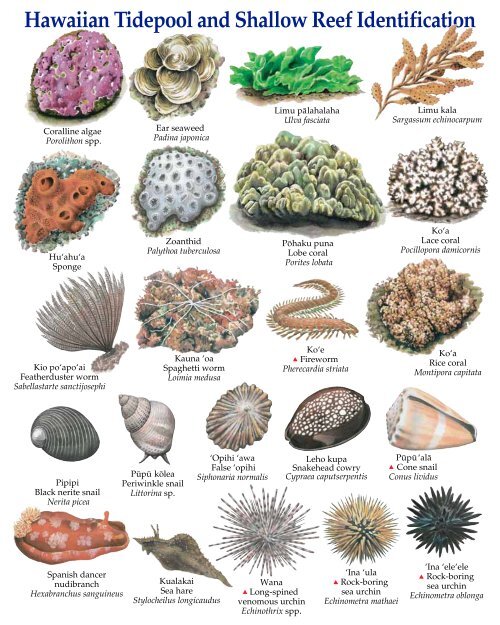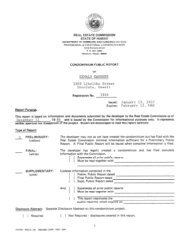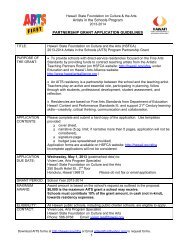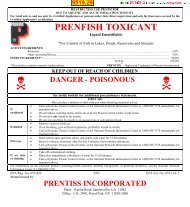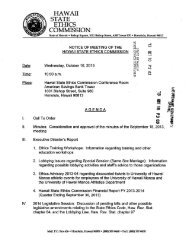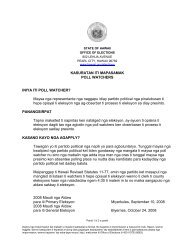Hawaiian Tidepool and Shallow Reef Identification - Hawaii.gov
Hawaiian Tidepool and Shallow Reef Identification - Hawaii.gov
Hawaiian Tidepool and Shallow Reef Identification - Hawaii.gov
You also want an ePaper? Increase the reach of your titles
YUMPU automatically turns print PDFs into web optimized ePapers that Google loves.
<strong><strong>Hawaii</strong>an</strong> <strong>Tidepool</strong> <strong>and</strong> <strong>Shallow</strong> <strong>Reef</strong> <strong>Identification</strong><br />
Coralline algae<br />
Porolithon spp.<br />
Hu‘ahu‘a<br />
Sponge<br />
Kio po‘apo‘ai<br />
Featherduster worm<br />
Sabellastarte sanctijosephi<br />
Pipipi<br />
Black nerite snail<br />
Nerita picea<br />
Spanish dancer<br />
nudibranch<br />
Hexabranchus sanguineus<br />
Ear seaweed<br />
Padina japonica<br />
Zoanthid<br />
Palythoa tuberculosa<br />
Pūpū kōlea<br />
Periwinkle snail<br />
Littorina sp.<br />
Kauna ‘oa<br />
Spaghetti worm<br />
Loimia medusa<br />
Kualakai<br />
Sea hare<br />
Stylocheilus longicaudus<br />
‘Opihi ‘awa<br />
False ‘opihi<br />
Siphonaria normalis<br />
Wana<br />
Long-spined<br />
venomous urchin<br />
Echinothrix spp.<br />
Limu pālahalaha<br />
Ulva fasciata<br />
Pōhaku puna<br />
Lobe coral<br />
Porites lobata<br />
Ko‘e<br />
Fireworm<br />
Pherecardia striata<br />
Leho kupa<br />
Snakehead cowry<br />
Cypraea caputserpentis<br />
‘Ina ‘ula<br />
Rock-boring<br />
sea urchin<br />
Echinometra mathaei<br />
Limu kala<br />
Sargassum echinocarpum<br />
Ko‘a<br />
Lace coral<br />
Pocillopora damicornis<br />
Ko‘a<br />
Rice coral<br />
Montipora capitata<br />
Pūpū ‘alā<br />
Cone snail<br />
Conus lividus<br />
‘Ina ‘ele‘ele<br />
Rock-boring<br />
sea urchin<br />
Echinometra oblonga
Pe‘a<br />
Brittlestar<br />
Ophiocoma sp.<br />
Hermit crab<br />
Calcinus seurati<br />
Kūhonu<br />
Swimming crab<br />
Charybdis hawaiiensis<br />
Āholehole<br />
<strong><strong>Hawaii</strong>an</strong> flagtail<br />
Kuhlia s<strong>and</strong>vicensis<br />
Pāo‘o<br />
Zebra blenny<br />
Istiblennius zebra<br />
Loli<br />
White speckled sea cucumber<br />
Actinopyga mauritiana<br />
Loli<br />
Black sea cucumber<br />
Holothuria atra<br />
Unauna<br />
Anemone hermit crab<br />
Dardanus gemmatus<br />
Kūpīpī<br />
Blackspot sergeant damselfish<br />
Abudefduf sordidus<br />
Mamo<br />
<strong><strong>Hawaii</strong>an</strong> sergeant damselfish<br />
Abudefduf abdominalis<br />
Safety First!<br />
• Check water conditions - watch out for strong surf <strong>and</strong> currents.<br />
• Wear proper footgear with grip on soles - fishermen’s tabis are best; old<br />
sneakers, reef shoes <strong>and</strong> diving booties are okay. DO NOT wear rubber<br />
slippers or s<strong>and</strong>als.<br />
• Beware of sharp or slippery rocks.<br />
• Walk slowly <strong>and</strong> watch for holes, crevices <strong>and</strong> drop-offs on the reef.<br />
• Don’t put your h<strong>and</strong>s or feet in holes or under ledges where you can’t see.<br />
Be careful of dangerous marine life, particularly those shown on this card.<br />
• If you don’t know what something is, don’t touch it.<br />
• Protect yourself from the sun.<br />
Produced by the Education Program<br />
Division of Aquatic Resources<br />
Department of L<strong>and</strong> <strong>and</strong> Natural Resources<br />
in association with the Waikīkī Aquarium<br />
‘Ōpae huna<br />
B<strong>and</strong>ed coral shrimp<br />
Stenopus hispidus<br />
Aloalo<br />
Ghost shrimp<br />
Family Callianassidae<br />
Pāpa‘i<br />
Pebble crab<br />
Family Xanthidae<br />
‘Ala‘eke<br />
Swimming crab<br />
Thalamita sp.<br />
© 1998 <strong>Hawaii</strong> Division of Aquatic Resources<br />
Aloalo<br />
Mantis shrimp<br />
Gonodactylus sp.<br />
‘A‘ama<br />
Rock crab<br />
Grapsus tenuicrustatus<br />
Nohu ‘omakaha<br />
Devil scorpionfish<br />
Scorpaenopsis diabolis<br />
‘O‘opu ‘ohune<br />
Brown tidepool goby<br />
Bathygobius cocosensis<br />
Puhi lau milo<br />
Undulated moray eel<br />
Gymnothorax undulatus<br />
Puhi kāpā<br />
Snowflake moray eel<br />
Echidna nebulosa<br />
Be a Good <strong>Reef</strong> Visitor!<br />
• Walk carefully <strong>and</strong> watch your step - use your lookbox; many sea creatures<br />
are fragile <strong>and</strong> you could crush them.<br />
• Move slowly so you see more.<br />
• Look more than you touch - try not to disturb creatures or their living places.<br />
• If you touch, do it gently - use just one finger, <strong>and</strong> always keep animals in<br />
the water.<br />
• Return rocks to their original positions.<br />
• Leave animals where you found them, <strong>and</strong> please don’t collect unnecessarily.<br />
• If you pick seaweeds, pinch, don’t pull.<br />
• Collect trash - leave the area cleaner than when you arrived.<br />
Funded in part by the Federal Aid in Sport Fish<br />
Restoration Program through your purchase of<br />
fishing equipment <strong>and</strong> motor boat fuels.<br />
Designed & illustrated by Les Hata


